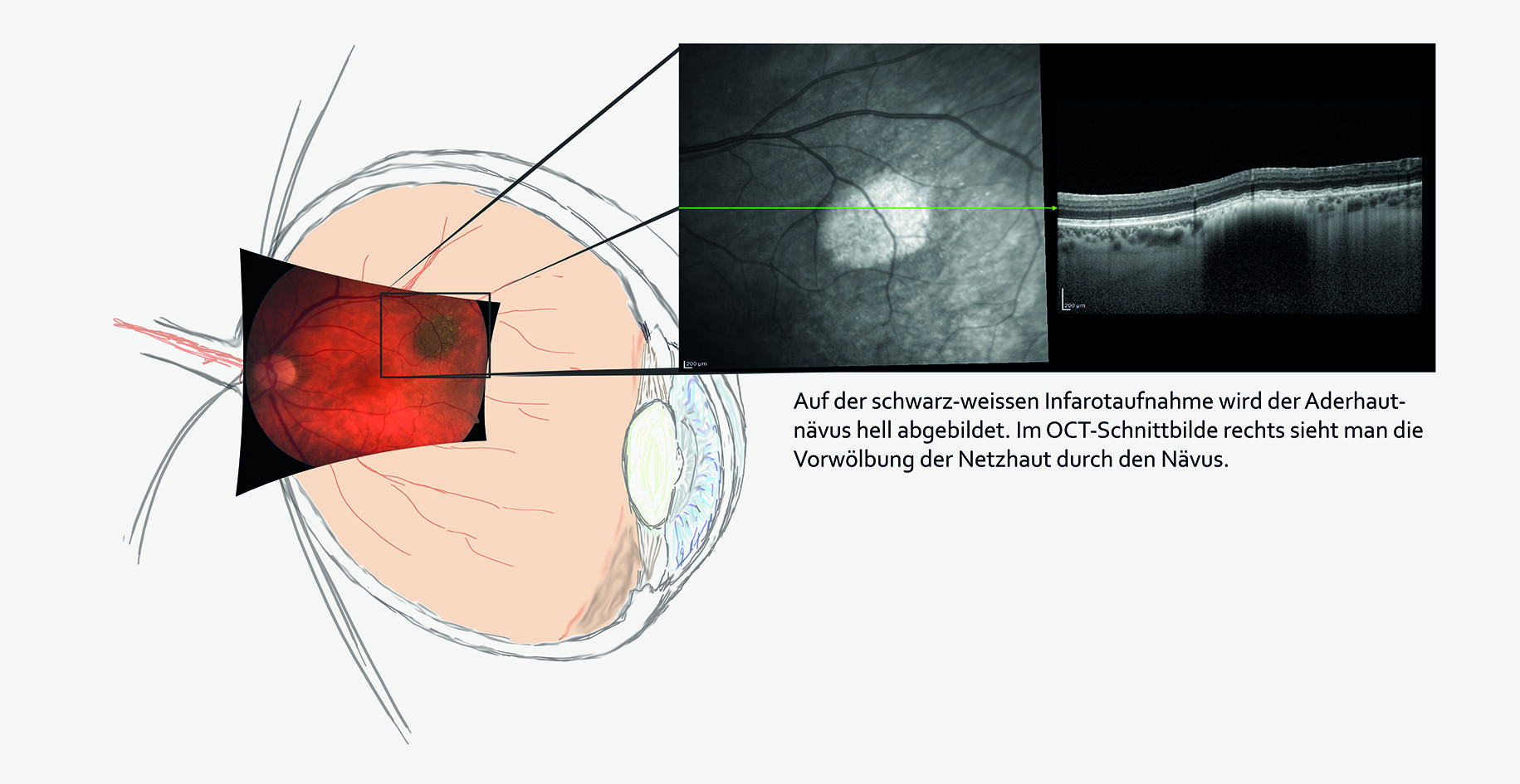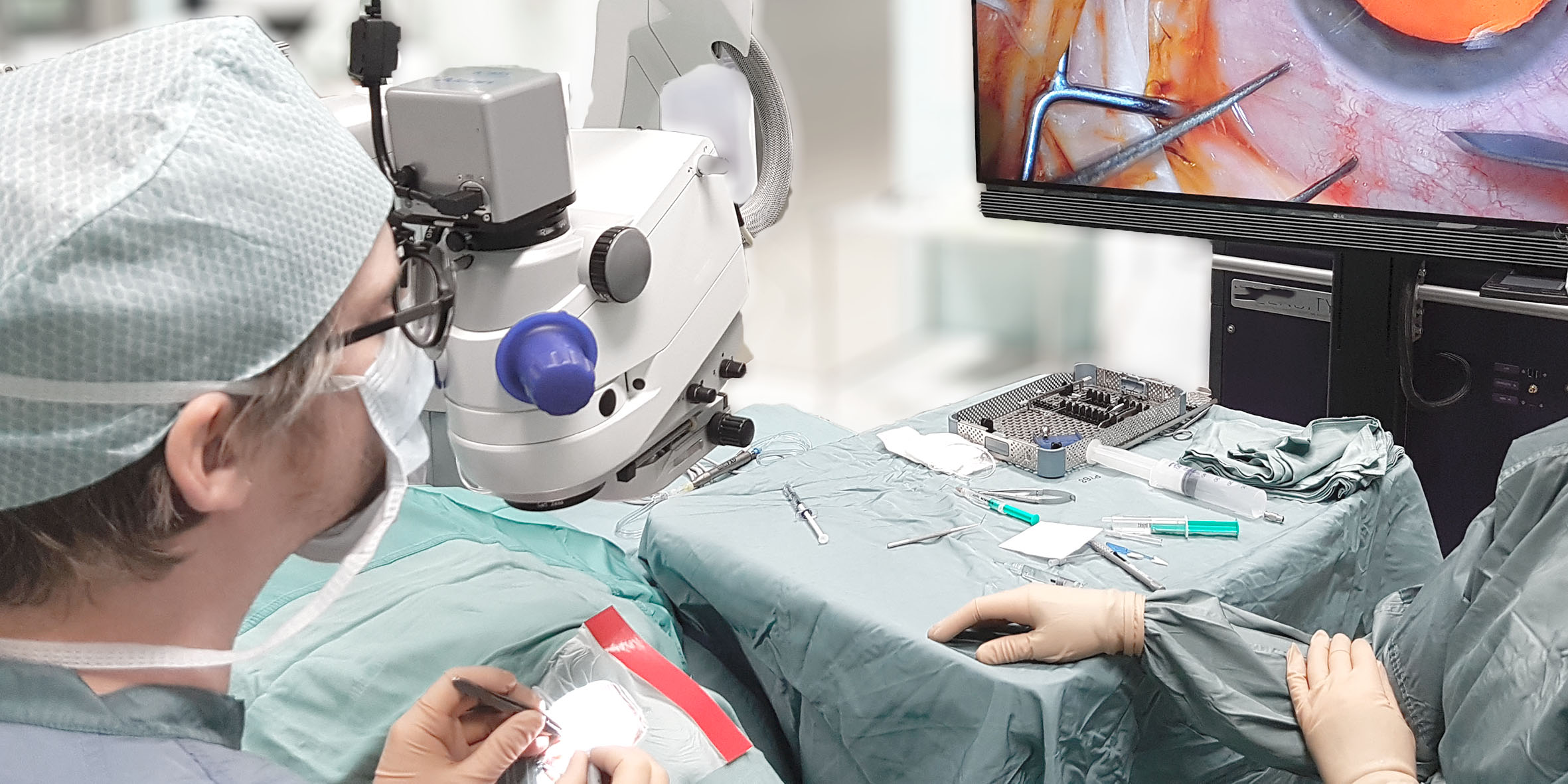
Pigmented choroidal melanoma with involvement of the macula
We can distinguish benign from malignant tumors, tumors in the eye and outside the eye.
Choroidal nevus – birthmark in the eye
About one in ten persons has a birthmark in the eye. In the choroid, the layer on which the retina lies melanocytes or pigment cells are found from which a birthmark can form. Most occur in adolescence.
What symptoms do you notice with a choroidal nevus?
A choroidal nevus usually leads to no visual impairment.
Check-ups and transformation risk of choroidal nevus
Similar to the case of the skin, there is also the possibility that a choroidal malformation changes into a malignant melanoma. Although this case is very rare, regular checks are still necessary. Depending on the findings (risk factors such as size, pigment, distension, location and vision problems), the control intervals should be selected – from months to years. Above all, the thickness and expansion of the controls must be checked.

Aderhautnävus
Uveal melanoma
Although the choroidal melanoma is the most common malignant tumor in the eye, it is generally rare. A choroidal melanoma arises like a choroidal nevus from the pigment cells in the eye, and may develop from a choroidal nevus. With therapy, most of the eye’s vision and vision can be maintained. Since a choroidal melanoma can scatter (especially in the liver), regular examination of the upper abdomen, the lung and the blood are required. The choroidal melanoma can be genetically examined by taking a sample. The prognosis depends on the respective change of the genetic information.
Iris nevi
Iris birthmarks are easily recognizable, especially with blue eyes. They are present already in childhood and as with the choroidal birthmarks, regular controls are necessary, although degeneration into a malignant iris melanoma rarely occurs.

Aderhautmelanom
Vascular tumors
There are several types of vascular tumors in the eye. They form either in the area of the retinal vessels or in the choroid. Vascular tumors are non malignant tumors, which means there is no development of metastasis. However, vascular tumors can cause problems in the eye that can affect your vision. Most of these complaints occur around the thirtieth to fortieth year of life. The most common vascular tumors in the eye are choroidal hemangiomas and retinal cavernous and capillary angiomas.
Tumors of the eyelid
As with the skin, various tissues of the eyelids, as well as the skin itself, the glands, muscles or pigment cells, can cause benign and rarely malignant tumors. In general, these are discovered by a person or by a physician as pigmented or skin-colored elevations in the area of the lids or the conjunctiva. The majority of them is surgically removed.
Therapy of eye tumors
In most benign tumors in the eye and if there is no risk for vision, a regular check is sufficient. However, if vision is compromised, for example by fluid exiting the tumor, or by other secondary changes, treatment is indicated for benign tumors as well. Here, mainly a laser therapy (photodynamic therapy, laser coagulation) or an intravitreal drug is used. In the case of malignant tumors, in particular in the case of choroidal melanoma, a radioactive irradiation of the tumor is carried out. For smaller melanomas, a radioactive disc (Ruthenium 106 applicator) can be sewn onto the outer skin of the eye. This is left for a few days, depending on the thickness of the tumor. The patient stays at the eye clinic during this time. For large tumors, external (external) radiation is the treatment of choice. There are different types of radiation: proton radiation, linear accelerator, CyberKnife or GammaKnife. These forms of therapy can usually ensure eye preservation even in the case of large malignant tumors. The appropriate form of therapy is applied for example at the Medical University of Graz, Department of Ophthalmology or in any other specialized clinics.



